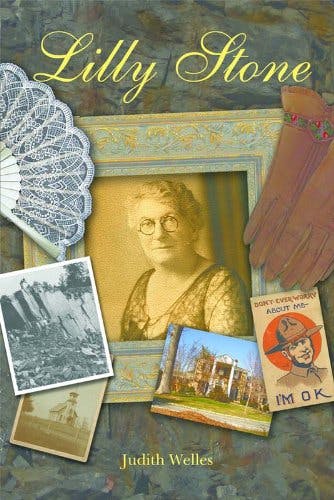Anita Schillhorn van Veen | November 18, 2020
Why is this interesting? - The Suburbs Edition
On the DC burbs, national historical Landmarks, and marketing tactics
Recommended Products

A book providing insight into the history of a preeminent quarry owner named Lilly Stone and her mansion, which plays a role in the history of the Carderock Springs area.
Anita Schillhorn van Veen (ASVV) is a friend of WITI and has a few other WITIs under her belt (Climate Tourism & Utopias). She runs strategy at ad agency McKinney’s Los Angeles market, and writes her own newsletter, which you can read here.
Anita here. My parents live in Carderock Springs, a suburb on the outskirts of Bethesda, Maryland. I spent my high school years here, in a woodsy cul-de-sac about 30 minutes from the center of Washington, DC. Our house is one of six models of subtle modernism built in the 1960s: clean lines, large windows, vaulted ceilings, and plenty of skylights. In my teenage years, I never considered it remarkable, but I was wrong—in 2008, long after I left, the neighborhood became a national historical landmark.
I dug into the history of the neighborhood to understand why this little suburban enclave warranted such acclaim. Prior to Carderock Springs, the area was a mix of the rich—a preeminent quarry owner aptly named Lilly Stone had her mansion here—and the not-rich—freed slaves set up a neighborhood around a church built on land bought by former slave Sarah Gibson. As Washington DC grew, so did interest in suburban living outside the Beltway.
Built between 1962 and 1967, Carderock Springs catered to the burgeoning middle class who sought fresh air and good design. Carderock’s developer, Edmund Bennett, had already built smaller subdivisions and poured all of his learnings into this new, modernist take on suburban living. It was designed to be a “visual community,” embedded in a forested topography. Rather than bulldoze the area for cookie-cutter lots, Bennett built his plan around large trees and natural land formations, and the houses are set at different angles on uniquely shaped lots nestled behind rocks and trees, which gives a sense of personalization as well as wooded privacy. There are no utility cords as all utilities are underground, and there’s no on-street parking, two subtle but impactful ways that the neighborhood maintains its connection to nature.
Why is this interesting?
What really struck me was the marketing techniques used to drum up interest in the new neighborhood.
Much of Carderock was built based on market research of what the “typical” suburban family desired, mainly outdoor space, privacy, and modernity. Bennett also did his fair share of comparative research, traveling around the US, Mexico, and Europe to explore planned communities.
The initial round of homes he built were called “applied research models,'' where he tested new materials and designs, and then opened them to the public to get their feedback, much like a beta test.
The staging of the home models was in keeping with the vibe that Bennett wanted; one model was staged with furniture by George Nakashima, who came in to approve the set-up, adding an esteemed modernist brand to the neighborhood. Bennett published a newsletter for the neighborhood; rather than choose a straightforward title, he branded it Esoterica. There’s even a set of brand guidelines, so to speak: a widely shared architectural vision statement with pillars around enhancing the growth of the hardwood forest, respecting the simplicity of the building, and extending the modern tradition.
It’s been quite a joy to dig into the history of the home where I spent my teen years, how my Nirvana posters hung on the walls of historic home, and that the wooded trails I took to sneak out to my hyper-local boyfriend’s house were part of a vision for a new way of living. (ASVV)
____
Partner Post: WITI x Brightland
As we near the holiday season, may we suggest gifting Brightland? Regular WITI readers will know we have been fans since launch. The brand was founded by Aishwarya Iyer (see our MMD with her here) with a distinctive aesthetic and strong vision to show people the benefits of real, quality olive oil. The brand has rolled out a range of new products, each designed to be front and center in your kitchen and with your cooking. The Essential Capsule is a perfect introduction and a perfect gift. It features Brightland’s core products, the now-classic AWAKE and ALIVE olive oils, as well as PARASOL, a raw champagne vinegar, and RAPTURE, a raw balsamic vinegar, double fermented with California zinfandel. In addition to gifting for your family and loved ones, you can also grab a subscription for yourself. Just like last time, they are kindly offering WITI readers 10% off of the Essential Capsule, with the code WITIESSENTIAL.
____
Election of the Day:
Los Angeles’ KCRW radio station hosts an annual tortilla tournament that gets reported with as much fervor as a general Presidential election. This year’s winner in an uncontested vote was HomeState’s flour tortillas. (ASVV)
Quick Links
Palm Springs apparently has the largest collection of modernist homes in America, and it’s being celebrated online at Modernism week in February. (ASVV)
Very looking forward to heading home and indulging in Vogue’s Harry Styles cover story. Digital is here. (ASVV)
The Middle East envisions post-Covid architecture. (ASVV)
Thanks for reading,
Noah (NRB) & Colin (CJN) & Anita (ASVV)
—
Why is this interesting? is a daily email from Noah Brier & Colin Nagy (and friends!) about interesting things. If you’ve enjoyed this edition, please consider forwarding it to a friend. If you’re reading it for the first time, consider subscribing (it’s free!).



